When looking for optimal heating schemes, they often forget about proven ways to maintain a comfortable temperature in the house. Along with traditional solid fuel boilers, in some cases it is optimal to use heating elements for heating a house with your own hands: batteries, radiators, boilers can include this heating element. However, before you start installing the equipment, you need to weigh the pros and cons.
- When is it advisable to use heating elements
- Rules for the installation and operation of heating elements
- Coolant quality
- Sealing joints
- Radiator electric home heating
- Connecting the heating element to the existing heating
- Radiator electric heating
- DIY electric boiler
- How to choose heating heating elements
- Prevention of breakdowns of heating elements
- The heating element in the boiler or boiler has broken
When is it advisable to use heating elements
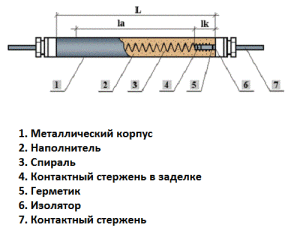
First of all, it should be clarified that it is not recommended to make a homemade ten for a heating battery. This is due to the observance of operational safety. In such structures, it is difficult to prevent a short circuit when an electric current enters the coolant. Therefore, heating with heating elements with your own hands should be done only with the use of factory models.
The heating element is a metal spiral with a high electrical resistance. It is enclosed in a metal shell that is filled with oil. This ensures the best heat transfer coefficient during the operation of the device. When connected to the electrical network, the spiral begins to heat up, transferring thermal energy to the surface of the shell. She, in turn, is a heat exchanger between the heating element and water.
It is important to use heating tendencies for heating in the following cases:
- Creation of heating systems without mains. To do this, you will need a heating element for a heating radiator with the ability to regulate power;
- They are part of electric boilers. If the factory models are too expensive, you can make an analog with your own hands. It is recommended to use a special heating element for the heating boiler as the main heating device. It is distinguished by increased power, in most cases it is designed for a voltage of 380 V;
- For quick heating of the room. Unlike solid fuel for a gas boiler, heating with electric tenami has a minimum heating agent heating time. If it is necessary to increase the temperature in the room in a short time, it is best to use this type of heating.
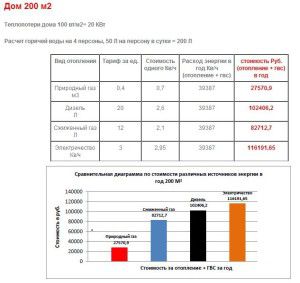
In addition, electric heating devices are small in size. They are successfully integrated not only into boilers and heating radiators, but also directly into the pipe. Thanks to this, the dimensions of the entire system are reduced, which is important for small houses and apartments. The disadvantage of heating on do-it-yourself tenths can be attributed to large running costs. In a comparative analysis of various energy sources, electricity will be the most expensive.
Is it really effective to use heating elements for heating radiators? Reviews contain often conflicting information. This is mainly due to the lifespan of the heater. The reason for this is incorrect installation and operation of the device.
The insertion of a heating element into the heating system can be done on your own. Manufacturers often include installation instructions with the device.
Rules for the installation and operation of heating elements
One of the main parameters for each electrical appliance is its rated power. The correct installation of the ten in the heating system is carried out only after calculating this value. To do this, you need to use a simple formula:
P = 0.0011 * m (Tk-Tn) / T
Where m - mass of energy carrier, kg,TC and Tn - the value of the water temperature after and before heating,T - the required time for the temperature to rise to the optimum TC.
For a 6-section aluminum radiator, m will be equal to 0.45 * 6 = 2.7 kg... Let's pretend that Tc = 80 ° C, but Тн = 20 ° С... The heating time should be 10 minutes. In this case, the optimal power that electric heating elements for heating radiators should have will be:
P = 0.066 * 2.7 (80-20) / 10 = 1.06 kW
In this case, it is taken into account that the coolant is water. With the use of antifreeze, the rated power of the heating element for the heating battery must be increased with a correction 1.44 - 1.06 * 1.44 = 1.52 kW.
Then you need to familiarize yourself with the rules for installing electric heating elements for heating a house.
The outer shell must always be in water. If this is not done, the heat from the coil will not be compensated for by the low water temperature. As a result, the heating element will quickly fail due to overheating. Therefore, the ten for heating the house is mounted at the lowest point of the radiator. In this case, it will not be in the possible zone of formation of air locks.
Coolant quality
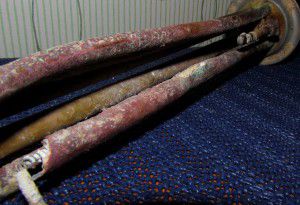
It is best to use distilled water as it contains a minimum% of impurities. When heated, they form a layer of scale on the surface of the protective shell. This leads not only to a loss of efficiency of the device, but is also the main cause of corrosion.
Sealing joints
When installing a ten in the heating system, you must first read the instructions from the manufacturer. If it indicates that the end joints of the electrodes must be additionally sealed, this must be done. Otherwise, if water gets on the surface of the heating coil, the danger to those living in the house increases. Having familiarized yourself with these rules, you can start installing a heating element for heating.
Not every heating element is suitable for a heating radiator. Only select special models with the appropriate mounting diameter.
Radiator electric home heating
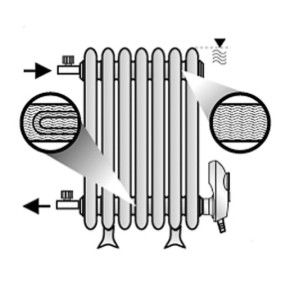
Before embedding the heating element into the heating system, the parameters of the radiator are needed. The main one is the diameter of the connecting pipe. Currently, manufacturers produce products in two sizes - 1/2 and 3/4 inches. Then a comparative analysis of the heating parameters is carried out before and after the installation of the heating element.
Connecting the heating element to the existing heating
If it will be used as an additional method of heating water, it is necessary to take into account the change in the hydraulic pressure when passing through the radiator. Since the flow diameter of the system will be smaller this month, it is recommended to install a larger pump.
When a radiator is connected to the system, the installation of a heating element for heating the house will be impossible. To do this, either change the wiring diagram to the top, or install a heating element on the top of the battery, which is not recommended by specialists.
Installation is often done in old cast iron batteries. Before carrying out work, you must first check the direction of the thread of the branch pipe (right or left) and also measure its diameter. Then you should adhere to the following scheme:
- Draining the coolant. It is forbidden to install a heating element in a heating radiator if there is water in it;
- Checking the battery level. Even with a small angle of inclination, the likelihood of the formation of air jams is significantly increased;
- Installation of a heating element in the pipe.To seal the holes, you must use the gaskets supplied with the heating element or make them yourself;
- Installation of a block with a thermostat, if there is one in the kit.
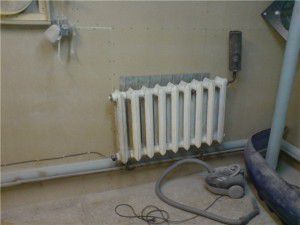
After that it is necessary to fill the system with water. With the help of the installed Mayevsky crane, possible air jams are removed. Before switching on, for safety reasons, a possible heating coil-battery circuit is checked using a tester. If it is, you need to dismantle the heating element and install it again, improving the sealing.
Radiator electric heating
When organizing self-made heating on heating elements, installation of the pipeline is not necessary. A heating element must be installed on each radiator. At the same time, it is possible to mount models of different power, depending on the thermal regime in a particular room of the house. The advantages of such a system are as follows:
- Saving on the purchase of materials and reducing the labor intensity of installation work;
- If a heating element with a thermostat for heating and a temperature sensor connected to it is used, the room heating degree will be adjusted automatically;
- Minimum heating inertia of the system.
But all these positive qualities can be overridden by the total cost of service. Therefore, before heating with electric tendens, you need to calculate not only the cost of purchasing materials and components, but also the subsequent costs of electricity. Only then should a heating system of this type be introduced.
It is recommended to purchase factory radiators with installed heating elements. The efficiency of their work is higher than that of home-made ones, since a special oil is used as a coolant. Even with the heating element turned off, it will give off heat to the room for some time.
DIY electric boiler
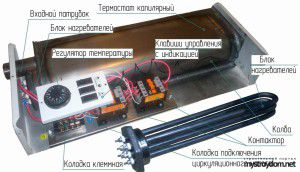
Is it possible to make a boiler that uses electric heaters to heat a house on your own? First you need to familiarize yourself with the design of factory models.
They consist of a unit with an installed heating element, a control and safety system. Unlike traditional boilers, it is small in size and can be installed almost anywhere in the system. For manufacturing, you will need the following tools and materials:
- Block of heating elements. It is best to use this type of heaters, as they have maximum power;
- Thermostat and temperature sensor;
- Steel body divided into two zones. One will house an electric heating element with a thermostat for heating, and the second will have a control and protection unit.
Since the ten in the heating system must be constantly in the water, it is recommended to install a liquid level sensor. The liquid is circulated through the inlet and outlet nozzles. To improve this process, a block for connecting the circulation pump is provided. But it should be noted that it is not recommended to make such boilers with a capacity above 9 kWt for a private house. This is due to the maximum load on the power grid and high overhead costs.
The installed additional heating element with a thermostat in heating can be used as a way to prevent the coolant from freezing. For this, the device can operate at minimum power.
How to choose heating heating elements
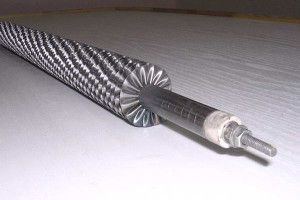
How to choose the right ten for the heating system? There are many manufacturers currently offering similar products. However, not always the quality and technical parameters correspond to the required ones. Therefore, before purchasing, you need to pay attention to the following performance characteristics of the heater:
- Rated and maximum power.If a heating element is needed in a heating boiler, its power must be enough for the system to work. The simplest way of calculating is for 10 sq. M. houses need 1 kW of thermal energy;
- Power supply type. For models with a power of up to 3 kW, you can use a 220 V home network. If it is planned to install a ten for a heating system of greater power, a three-phase 380 V network should be installed.This may be due to difficulties in the preparation of documentation;
- The presence of a thermostat. For a radiator electric heating system, this is the main selection factor. If you buy a ten without the ability to adjust the power, it will constantly work at maximum mode. Thus, the cost of electricity will rise sharply;
- Cost. The average price of a 2 kW model starts at 900 rubles. The cost of more powerful ones can be up to 6,000 rubles. They are often made to order.
The appearance of the heating element can also affect its performance and efficiency. The best option would be to purchase a ribbed heating element for the heating boiler. It differs from the usual ones in that additional heat exchange plates are located on the protective shell.
Thanks to them, the heating area increases. This design is typical for heating elements in heating radiators of a larger diameter. Reviews about them speak of increased heat transfer even with a minimum operating mode. But their overall dimensions do not always make it possible to install in a battery. Therefore, most often they purchase simple tube-type heaters. To increase the efficiency, you can buy a block of heating elements with a thermostat. It differs from traditional ones by the presence of several heating elements on one base.
Prevention of breakdowns of heating elements
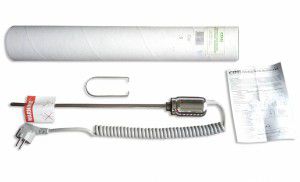
Even after it has been possible to professionally embed the heating element of heating systems, the rules of operation must be observed. First, the ability of the power grid to withstand maximum loads is checked. To do this, you need to add up all the power of electrical appliances in the house and add a factor of 1.2 to the resulting figure for the power reserve. The cross-section of the wiring must withstand the rated power without overheating or short-circuiting.
The work of the heating elements in the device is the gradual destruction of the heating coil. Therefore, shades intended for radiators must have a maximum service life of at least 10 years, which is confirmed by the manufacturer. In addition, you need to follow these rules:
- Do not add tap water to pipes or radiators. This can lead to the formation of limescale on the surface of the heating element. Use only distilled water;
- Installation of an RCD (residual current device) is required. One or several heating elements can be connected to it. In the event of an emergency, this device will cut off the power supply;
- Frequent turning on and off of the ten when heating the house reduces its service life;
- If static electricity is observed on the surface of the battery, an urgent need to check the tightness of the heating element;
- Installation of a heating element in a heating boiler or radiator without grounding is prohibited.
Guided by these simple recommendations, you can make not only an effective, but also a safe heating system for a private house or apartment using electric heating devices.
It is impossible to install ten in the heating system without first checking the grounding. To do this, it is best to use the services of an electrical laboratory.
The heating element in the boiler or boiler has broken
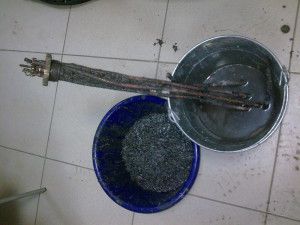
Despite its reliability, failure of heating electric heating elements is quite common. If this is a factory model, you can do self-repair only if you have confidence in your own abilities.It is best to contact a specialized company, since in addition to the heating element, unqualified repairs can damage other important parts of the system.
If a decision is made to independently restore the boiler's performance, you first need to familiarize yourself with its design. To do this, you can use the data from the passport or view the data on the manufacturer's website. Before dismantling the heating coil, the device must be secured. Then the coolant is drained. You can check the performance of the heater using the indicator. The passport must indicate the resistance indicator when the circuit is closed. If the indicators do not coincide with the initial ones, a new heating element is installed. The best option is to install a similar device from the same manufacturer.
Before you embed the heating element into the heating system, you need to make good thermal insulation in the apartment or house. This will reduce the running electricity costs, which in turn will increase the life of the heating element.
To check the performance of the heating element, it is recommended that you familiarize yourself with the video material.







